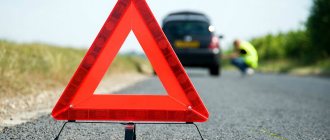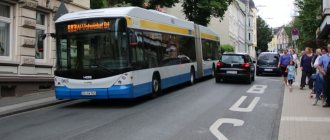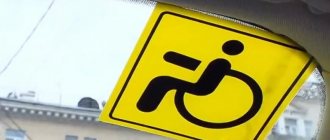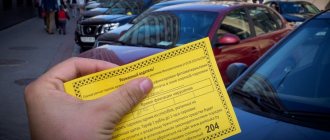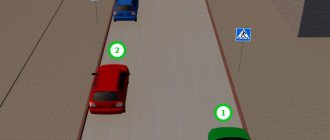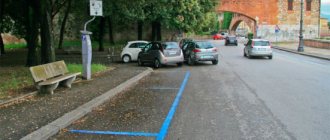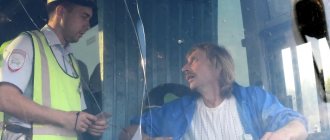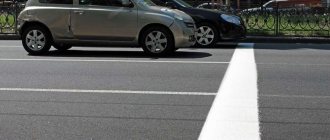Bus stop sign concept
As required by the rules, the presentation of the sign must be two-sided. Its image provides information to passing and oncoming traffic about special sections of the road, about various city transport stops, as well as for them to take safety measures:
- reduction in speed,
- don't overtake
- pay attention on pedestrian areas,
- maneuvering according to traffic rules.
A bus stop sign, like any other sign, notifies the driver of the necessary actions on a certain section of the road.
Exam questions for sign 3.27 “Stopping is prohibited”
Ticket No. 7 Question No. 3
How does a road sign prohibit parking work?
Are you allowed to stop at the indicated place?
1. Yes.
2. No.
Comment: In this situation, the coverage area of sign 3.27 “No Stopping” is limited by the length of the solid yellow line 1.4 marked at the edge of the roadway. You can stop anywhere after it ends.
Ticket No. 13 Question No. 3
Are you allowed to park in the indicated area?
1. Yes.
2. No.
Comment: The coverage area of sign 3.27 “No Stopping” extends to the nearest intersection, and the gap in the dividing strip of the road is not an intersection, therefore, by parking your car in the indicated place, you will violate the requirement of the prohibition sign.
Ticket No. 14 Question No. 6
Do you have to stop at the request of the traffic controller at the place indicated by him?
1. Yes, but only with access to the sidewalk.
2. Yes.
3. No.
Comment: Clause 6.11 of the rules. Drivers are obliged to follow the orders of the traffic controller even in cases where they contradict the requirements of road signs and markings. You must stop at the curb.
Ticket No. 15 Question No. 7
In this situation, should a driver stopped due to a problem display a warning triangle?
1. Shouldn't.
2. Should if the alarm system is faulty.
3. Must in all cases.
Comment: Clause 7.2. rules When a vehicle stops and the hazard warning lights come on, as well as when they are malfunctioning or missing, an emergency stop sign must be displayed immediately.
Ticket No. 20 Question No. 3
Are you allowed to stop behind a sign?
1. Allowed.
2. Permitted only for boarding or disembarking passengers.
3. Prohibited.
Comment: Plate 8.2.4 “Validity area” under sign 3.27 “Stopping is prohibited” informs you that you are within the coverage area of sign 3.27, installed earlier, i.e. You cannot stop either before or after the sign.
Ticket No. 24 Question No. 3
Are you allowed to park your car in the designated area?
1. Allowed.
2. Allowed if you live near this place.
3. Prohibited.
Comment: Sign 3.27 “Stopping prohibited” with plate 8.2.3 “Availability zone” (Appendix 1) is installed at the end of the stopping prohibition zone. By parking your car behind a sign, you will not break the Rules.
Ticket No. 27 Question No. 3
What vehicles are allowed to stop in the area of the sign?
1. Route vehicles only.
2. Only taxis with the taximeter turned on.
3. Only cars driven by disabled people of groups I and II or transporting such disabled people.
Comment: The only type of vehicles that are not covered by sign 3.27 “Stopping Prohibited” are route vehicles, which can stop at designated stopping places within the sign’s coverage area.
Ticket No. 34 Question No. 3
What vehicles are allowed to stop in the area of the sign?
1. Only taxis with the taximeter turned on.
2. Only for cars with the “Disabled” identification badge installed.
3. All listed vehicles.
Comment: With sign 3.27 “Stopping prohibited”, sign 8.18 “Except for disabled people” is used, which indicates that the ban on stopping does not apply to motorized wheelchairs and cars with the “Disabled Person” identification sign. This sign is installed on vehicles driven by or transporting disabled people of groups I and II.
Ticket No. 39 Question No. 3
In which of the following places can you park your car?
1. Only A.
2. Only B.
3. In no way.
Comment: The coverage area of sign 3.27 “No Stopping” in this case extends to the nearest intersection. Therefore, you can park your car on the side of the road behind the intersection. The correct answer is Only B (clause 12.1).
What does the sign look like according to GOST?
This is what a bus stop sign looks like according to GOST requirements. It is installed at the beginning of the stop; if there is a pavilion on the site, you can install it on the edge so that the sign is visible to approaching vehicles.
In the city, the sign must be double-sided; single-sided ones are used outside the city on roads where there are areas with a dividing strip, in the absence of pedestrian traffic along the road.
If it is necessary to indicate the length of the stop area, which is not very pronounced, or to indicate the next stopping points located, it is permitted to use a bus stop sign with table 7.2.1., which indicates it or the total length of the remaining areas.
Additional inscriptions are placed on the sign in its lower part. This sign is installed at the beginning of the stop.
Placements
A special sign such as Bus Stop (5.16) must be located in appropriate places. It is installed on those sections of roads where stops intended for public transport are located.
The rules stipulate that the sign should be placed in the middle or at the end point of a special zone allocated for a stop. But in some cases the extent of such zones is quite impressive. In such situations, the pointer is re-installed at 2 or more points.
It is also important to note that at a bus stop, signs are predominantly used of a double-sided type. This way, oncoming drivers can find out in time that there is a stop ahead for the safe disembarkation of passengers, and take appropriate measures. That is, slow down, watch for pedestrian crossings, etc.
On urban roads, GOST necessarily provides for the use of a double-sided sign. Outside the city, one-way signs can also be used if there is no pedestrian crossing on the site. Sometimes the sign is supplemented with inscriptions. This is done over long areas. Additional inscriptions are applied below, under the sign. The sign itself is placed at the starting point of the stopping zone.
The new rules provide for the possibility of combined use of signs and special road markings. The latter is made in the form of a broken line and is yellow. The marked area also indicates the operation of the Bus Stop sign in this area. The rules and prohibitions apply the same as when simply using a standardized sign. The absence of a sign, but the presence of markings, does not relieve the driver who violated the traffic rules from liability.
Types of bus stops
These are special designated areas for the safe embarkation and disembarkation of passengers of ground transport buses, trolleybuses, trams, and minibuses. Indicated by a sign that corresponds to a specific stop.
They are always equipped with a sign indicating:
- route numbers stopping at this location,
- public transport schedule,
- route maps.
The bus stop must be equipped with special equipment in accordance with GOST:
- road signs,
- markings,
- traffic lights and fences.
There are two types of bus stops or car pavilions: open ones are canopies, closed ones are a structure blocked on three sides; for the convenience of passengers, benches are installed so that they can wait out bad weather, snow, and rain in a shelter.
Outdoor advertising or ticket sales points may also be placed, but concession kiosks are prohibited. Within the designation of a public transport stop, there is a road mark - a taboo for parking cars.
There are two types of main stops:
- permanent stop - the stay of transport according to an approved schedule, after a certain period of time,
- upon request - identification signs are not always present at such a stop site. A waiting passenger, by raising his hand or pressing a button, if any, can stop the approaching vehicle, otherwise the bus or minibus will pass by.
Punishment for violating traffic rules
In the traffic rules, the “Public Transport Stop” sign is classified as a group of special instructions. That is, it makes a certain driving mode mandatory for some vehicles and also clearly establishes different rules for others. Their violation makes it necessary to apply the Code of Administrative Offenses:
- If a motorist parks in the area covered by the symbol, he will be fined 1,000 rubles. The punishment is provided for in Part 3.1 of Article 12.19 of the Code. And in Moscow and St. Petersburg, for the same thing, the violator will be required to pay 3,000 rubles. under Part 6 of Article 12.19.
- If the car turns around at a bus stop or taxi rank, its driver will give 500 rubles. This punishment is provided for in Part 2 of Article 12.14 of the Code of Administrative Offences. It is also used for those who were driving 5.16 in reverse.
- If a car stops moving at a public transport stop to let people off, but at the same time becomes an obstacle for the bus, the driver also has the right to be punished. Part 3.1 of Article 12.19 of the Code will be applied to him.
- If a car “cut off” a bus in order to get to the bus stop faster, or prevented it from leaving the site, the driver’s actions fall under Part 1 of Article 12.17 of the Administrative Code. This is a fine of 500 rubles.
How to stop at a bus stop?
A car is a complex piece of equipment, and some problems may arise unexpectedly. At such a moment, the driver cannot objectively assess the situation and quickly, without a preliminary inspection, identify a breakdown of any part of the car; these can be faults of different tones:
- steering and brake systems,
- damage to dimensions and headlights,
- malfunction of windshield wipers in bad weather.
If in this case you had to use parking at a stop, then this is not considered a violation and does not threaten the “violator” with a monetary penalty.
Don't forget to put out the emergency stop sign. Dangerous malfunctions detected in the operation of the vehicle prohibit further use. First of all, public needs are taken into account; there must be compelling reasons for stopping at the bus site.
If you had to stop, then you need to do it without interfering with the main transport to freely disembark and pick up passengers.
Parking to the bus stop sign
Parking means parking a vehicle on the edge of the road or in a designated area for a long period of time.
But parking cannot be done 15 meters before and after a public transport stop, but it is possible if personal transport does not interfere with public transport. The calculation is made based on the sign indicating the stop, regardless of which side the car is on.
Who is allowed to stop for more than 5 minutes?
At a bus stop, a motorist can disembark and pick up people from his vehicle.
It is also possible to load and unload cargo into a vehicle, provided that the vehicle is parked for no more than 5 minutes, without interfering with passengers or the movement of shuttle buses. An emergency stop of a car is allowed on a bus in the event of a breakdown and the ability to quickly fix it.
How many meters before should you stop?
The car must stop 5 meters before the pedestrian crossing, after it the distance does not matter, the main thing is not to stop at the zebra crossing.
For two-way traffic, the action is the same.
Possible situations: what to do?
Even the most careful and prudent people can sometimes find themselves in very awkward and unpredictable situations, which can sometimes be serious. Quite often it happens that on a clearly visible section of the highway, where the “Bus Stop” sign provided for in paragraph 5.16 is in effect, the driver makes an illegal stop, turns around or moves in reverse, or, even worse, thinking or distracted by extraneous matters, heads down the road. the route he needs without giving way to the bus.
The sign is installed in the middle or at the end of the stopping zone
If such an action was noticed by a traffic police officer, most likely the negligent driver will be “rewarded” with a fine. However, there are situations when unexpected spending can be avoided. A driver who violates the rules can avoid a fine if the corresponding sign is actually missing or the road surface does not have the necessary markings.
The person must point out to the law enforcement officer that, even though there is actually a stop for minibuses, an important formality has not been observed on a particular section of the road, i.e. there are no installed signs and appropriate markings. Only in this case can you try to prove legal innocence, due to which the driver did not violate the rules and, accordingly, administrative penalties in the form of a fine or other penalty cannot be applied to him.
Traffic rules when boarding and disembarking passengers at a stop
The rules state that boarding and disembarking passengers at a public stop is permitted and is carried out after a complete stop of transport from the side of the road or sidewalk, provided that it does not interfere with other vehicles.
And it is not recommended in places where it is prohibited to do this; in this regard, there is an article subject to a fine from a small amount to an impressive amount.
Here are some prohibited places:
- where the prohibition sign hangs,
- when tram travel is restricted on its tracks,
- railway track,
- in the tunnel,
- no more than 15 meters before and after a pedestrian crossing, intersection,
- in narrow areas,
- in the bike lane.
It is necessary to know and adhere to traffic rules.
In this situation you:
| 1. | Must give way to a bus starting from a designated stop. |
| 2. | You have an advantage because the bus driver starts moving into the second lane. |
In a populated area, you must give way to a bus starting from a designated stop, even if its driver enters the second lane.
Fines for violation
If for some reason the driver had to stop at the site designated as a stop, then the possible actions of the traffic police officer who detected the violation:
- issuing a fine, the amount may fluctuate,
- or to evacuate the vehicle that violated the rules.
The driver's obligation will include payment for transportation and security in the parking lot of the seized vehicle. The best option would be for the car owner to independently eliminate the obstacles created by his vehicle.
Also, a fine may be imposed for reasons of incorrect parking:
- which creates interference,
- parking in front of a pedestrian crossing,
- in places reserved for disabled people,
- when parking second row,
- on playgrounds,
- on the lawn,
- sidewalk.
In order not to find yourself violating the rules and not having to pay fines, tow truck services and impound parking, you should try to park at bus stops for a few minutes and for good reasons, without creating any difficulties for the movement of public transport.
When disembarking or picking up passengers, it is better to park before or after the bus stop within fifteen meters.
How many minutes can you stand
3.27. prohibits stopping the vehicle, that is, as stated in paragraph 1.2. Traffic rules, intentional stopping of the movement of a car for a period of up to 300 seconds, except in cases of boarding or disembarking passengers (or loading/unloading a vehicle) - in this case, stopping movement for a period of more than 300 seconds will be considered a stop.
3.28. prohibits only the parking of a vehicle, that is, the deliberate cessation of vehicle movement for a period of more than 5 minutes, if this is not related to the embarkation/disembarkation of citizens or the loading/unloading of a vehicle.
Obviously 3.27. does not allow you to stop or stand, but 3.28. - just stand.
Conversation with the inspector in case of violation
The reason for the absence of a road sign may be several factors:
- Having opened a new stop, the installation of the sign was postponed for a while,
- The previously installed sign was damaged, it was removed, and a new one was not installed.
But no matter how the reason influences the absence of a sign, the driver who violated the rules, with a sense of tact, in an unobtrusive form, can try to assure the traffic police inspector of his innocence. And then the likelihood of avoiding a fine will increase.
What to do if there is no sign
There are 2 exceptional situations in which the sign may be missing, but the inspector will still issue a fine.
- Road service employees have not yet had time to install the corresponding sign, since the stop is new and work is underway to equip it.
- The old sign is broken and the new one has not yet been installed.
A driver can be perfectly understood when he is given a fine in the absence of prohibitory signs. But swearing and quarreling with the inspector will definitely not achieve anything good here.
Also, some drivers who find themselves in a new city or other area for the first time may not notice a sign that is covered with branches, billboards or other objects. In this situation, it is very difficult to prove that you are right. Lawyers and experienced motorists who are faced with such injustice are advised to record everything that happens in a photo or video. With such evidence you can go to court and challenge the fine.
HYDROTECHNICAL AND WATER TRANSPORT OBJECTS
191 Canalized sections of rivers, canals and ditches width [122, 123]: 1) up to 3 m 2) from 3 to 5 m 3) 5 m and more (shown on map scale) * Width at the top and bottom (numerator) and depth (denominator) of canals and ditches in m 192 Ground concrete canals and ditches [122, 124] 193*
Underground canals and underground drainage network [122, 125] 194 Canals under construction [122, 127] 195 Dry ditches width [122, 126]:1) up to 3m
2) from 3 to 5 m 3) 5 m or more (shown on map scale): 8 - ditch width in m, depth. 3 m - ditch depth:Table No. 26
| No. conditional signs | NAMES OF CONVENTIONAL SIGNS | IMAGE |
| 196 | Rivers, canals and ditches with dams or rollers on one or both sides (2 - dam height in m)[ 127] | |
| 197 | Dams, artificial shafts and ridges, dams near dry reservoirs (3-height in m) [127] | |
| 198 | Canalized sections of rivers, canals and ditches in excavations on one and two sides (5 and 2 depths of excavations in m) [123] | |
| 199 | Water distribution devices (regulators, etc.), on irrigation canals [128] | |
| 200 | Water distribution devices (regulators, etc.), combined with road bridges (1 and 3) and pipes (2) [128] | |
| 201 | Water outlets on dams and estuary irrigation rollers | |
| 202 | Dukers [129] | |
| 203 | Aqueducts [129] |
Table No. 27
| No. conditional signs | NAMES OF CONVENTIONAL SIGNS | IMAGE |
| 204 | Spillways (connecting structures): 1) fast currents and step differences (3-height of water drop in m) 2) cantilever discharges (4-height of water discharge in m) | |
| 205 | Streams, channels or ditches passing through pipes [130] | |
| 206 * | Drive-through dams, the width of which is expressed on a map scale (215-length, 20-width of the dam at the top in m, Bet, - Earth-material of the structure, fraction-marks of the water edges of the upper and lower pools) 115.5-mark on the dam crest [131] | |
| 207 * | Road dams, the width of which is not expressed on the map scale [131] | |
| 208 * | 1. Impassable dams (230-length. 3-width of the dam at the top in m, Earth-material of the structure, shot-mark of the water edge and elevation mark at the base of the dam) [131, 132] 2. Reserve bypass ditches 3. Flooded areas forests, trees and shrubs [132]- | |
| 209 | Underwater dams [131] | |
| 210 | Dams with gates for the passage of rafts [131] a b | |
| 211 | Broken dams a b |
Table No. 28
| No. conditional signs | NAMES OF CONVENTIONAL SIGNS | IMAGE | |
| 212 | Gateways expressed in map scale [133] 1. Chambers (90-chamber length, 30-gate width, 3.5-depth at gate threshold in m) | ||
| 2. Gates (locks) of sluices | |||
| 213 | Gateways not expressed at map scale [133] | ||
| 214 | Sluice gates with bridges [133] | ||
| 215 | Stone, concrete and reinforced concrete embankments [134] | ||
| 216 | Wooden embankments [134] | ||
| 217 | Descents and stairs on embankments [134] | ||
| 218 | Banks with planned, unreinforced slopes [134] | ||
| 219 | Banks with reinforced slopes [134] | ||
| 220 | Banks with reinforced slopes and a berm more than 1 m wide [134] | ||
| 221 | 1. Water measuring posts and foot rods [135] | ||
| 2. Water-measuring stations with equipped gauging stations [135] | |||
| 222 | Marinas with equipped berths [136] | A | |
| b | |||
| 223 | Jetties, berths, piers [137] | a b | |
Table No. 29
| No. conditional signs | NAMES OF CONVENTIONAL SIGNS | IMAGE |
| 224 | Anchorages, stopping points and marinas without equipped berths [138] | |
| 225 | Railways along the pier | |
| 226 | Breakwaters, traverses, groins, etc. structures [139] | |
| 227 | Sea channels [140, 141] | |
| 228 | Rail ferries | |
| 229 | Lighthouses [140] | |
| 230 | Lights (illuminated shore navigational marks) [140] | |
| 231 | Permanent coastal signal signs with landmark value [142] | |
| 232 | Lightships with one light [140] | |
| 233 | Lightships with two lights [140] | |
| 234 | Light Buoys [140] |
Table No. 30
| No. conditional signs | NAMES OF CONVENTIONAL SIGNS | IMAGE | |
| on the original filming | on a colorful print | ||
BRIDGES AND FERDS
252 Single-span metal bridges more than 13 m long [152, 153] 253 Multi-span metal bridges (two-span in the sample) [152, 153] 254 Metal lifting and drawbridges [152, 153] 255 Stone, concrete and reinforced concrete single-span bridges [152, 153 ] 256 Stone, concrete and reinforced concrete multi-span bridges (three-span on the sample) [152, 153] 257 Stone, concrete and reinforced concrete lifting and drawbridges [152, 153] 258 Single-span wooden bridges [152, 153, 154] 259 Multi-span wooden bridges (on the sample - two-span) [152, 153] 260 Wooden lifting and drawbridges [152, 153] 261 Bridges on floating supports (rafts, ships, pontoons) [152, 153] 262 Chain and rope bridges [152, 153] 263 Double-tier bridges with a highway under the railway (on the example - a stone, concrete or reinforced concrete two-span bridge) [152, 153] 264 Double-tier bridges with a highway above the railway (on the example - a metal single-span bridge) [152, 153]Table No. 33
| No. conditional signs | NAMES OF CONVENTIONAL SIGNS | IMAGE |
| 265 | Bridges with railroads and highways passing nearby [152, 153]. 1) on a common span | |
| 2) on separated spans, but on common supports | ||
| 266 * | Characteristics of bridges [153, 155]. 8 is the height of the bottom of the span above the water level (on navigable rivers), 182 is the length of the bridge, 6 is the width of its roadway in m; 30-vehicle load (carrying capacity) in t; 97.6 - floor height mark | |
| 267 * | Bridges with a length from 3 to 13 m and their characteristics [152, 153, 154, 155]: 1) metal, stone, concrete and reinforced concrete bridges | |
| 2) wooden bridges | ||
| 3) chain and rope bridges | ||
| 268 | Bridges less than 3 m long [156] | |
| 269 * | Characteristics of bridges less than 3 m [157]: 112.6-level of the bridge deck; 2-length along the deck, 5-width of the roadway in m | |
| 270 | Pipes under roads [157] | |
| 271 * | Characteristics of pipes under roads [157]: 157.5 and 62.8 elevations of the road surface above the pipes; 1.0 and 0.6 - internal diameter of pipes in m; 2-number of pipes; Bet., M-pipe material |
Table No. 34
| No. conditional signs | NAMES OF CONVENTIONAL SIGNS | IMAGE |
| 272 | Pedestrian bridges [156, 158] | |
| 273 | Pedestrian suspension bridges [158] | |
| 274 | Pedestrian bridges with steps [158]: | |
| 1) stone, concrete, reinforced concrete and metal; | ||
| 2) wooden | ||
| 275 | Ferries with a mechanical engine (145-river width, 8×6-size of ferry cargo deck in m, 30-carrying capacity in tons) [159] | |
| 276 | Ferries (140-river width, 4×3-size of ferry cargo deck in m, 8-carrying capacity in t) [159] | |
| 277 | Boat transportation with mechanical engine [160] | |
| 278 | Boat transportation [160] | |
| 279 | Fords and their characteristics: the numerator is the depth and length of the ford in m, the denominator is the nature of the bottom soil and the current speed in m/s [161] |
Table No. 35
| No. conditional signs | NAMES OF CONVENTIONAL SIGNS | IMAGE |
Requirements for stopping points
In accordance with the state requirements of the national standard, Article 5.3 of GOST R 52766-2007 “Public automobile roads. Arrangement elements. General requirements" - The stopping point must consist of the following elements: - stopping area; — landing site; — waiting area; — transitional express lanes; — drive-in pocket; — side dividing strip (for roads of I-III categories); — sidewalks and pedestrian paths; - crosswalk; — car pavilion; - benches; — toilet (after 10-15 km for roads of I-III categories); — container and trash cans (for roads of category IV only a trash can); — technical means of organizing traffic (road signs, markings, fences); — lighting (at a distance of no more than 500 m to the place of possible connection to distribution networks). This is also stated in the requirements of OST 218.1.002-2003 Bus stops on highways.
In accordance with the state requirements of the national standard, Article 5.1.3 GOST R 50597-2017 “Roads and streets. Requirements for operational condition acceptable under the conditions of ensuring road safety" - The covering of landing areas of stopping points must be free of contamination (garbage, dirt) and individual destruction with an area of more than 0.2 m. Contamination must be removed within 3 days, individual destruction - within 7 days.
In accordance with the state requirements of the national standard, Article 5.6.23 of GOST R 52289-2004, stopping points must be equipped with road signs 5.16 or 5.17, depending on the type of public passenger transport.
Based on paragraph 6 of Article 19 of the Federal Law of November 8, 2007 No. 259-FZ “Charter of Automobile Transport and Urban Ground Transport”, information about the type of regular transportation of passengers and luggage, schedule, start time must be posted at each stopping point along the route of regular transportation and the end of the movement of vehicles along the corresponding route, the name of the final stopping point of the route, information about the name, address and contact telephone numbers of the body exercising control over the regular transportation of passengers and luggage.
Paved roadside
When stopping on such roadsides, general rules apply, but some nuances should be taken into account. Roadsides of this type can be either unpaved or covered with gravel. In both cases, braking maneuvers and pulling over to the side of the road should be performed with caution.
You need to make sure that the coating holds the car. It is better if the left side of the vehicle is on the edge of the hard road surface, so that there are no difficulties when starting to move and the car does not get stuck.
It should be taken into account that in heavy rain on such a side of the road the car can sag and get stuck. If he leaves, the accumulated dirt can lead to skidding, which is fraught with consequences. Clods of dirt flying out from under the wheels of the vehicle will create a danger to surrounding traffic. They can end up on the road or in passing cars.
You need to be extremely careful at night, as visibility is difficult at this time. It is recommended to check the shoulder before driving completely onto it.
Side paths or dead-end exits should not be neglected either. They are also suitable for a temporary stop.
When stopping a vehicle on a slope, you need to apply the parking brake, turning the wheels towards the side of the road. So, if something happens, the car will not be able to enter the roadway.
GEODETIC POINTS
1 Points of the state geodetic network [, , ] 2 The same [32, 14, 15]:1) on mounds (2-height of the mound in m)
2) on rock outcrops (5 is the height of the outcropping rock in m) 3) on buildings 3 Points of geodetic condensation networks and survey network points fixed on the ground by centers [13, 14, 15] 4 The same [13, 14, 15 ]:1) on mounds (1-height of the mound in m)
2) on rock outcrops (4-height of rock outcrops in m) 3) churches that are points of geodetic condensation networks or survey networks a b 5 Astronomical points [] 6 Leveling marks and ground benchmarks (numerator - mark of the center of the sign, denominator - ground level) [14, 15] 7 Leveling marks and rock benchmarks (5 is the height of the outcropping rock in m) [14, 15,16] 8 Boundary posts (boundary marks) that have the value of landmarksTable No. 2
| No. conditional signs | NAMES OF CONVENTIONAL SIGNS | IMAGE | ||
| on the original filming | on a colorful print | |||
Dirt shoulder
Even if cars do not often drive on dirt roads, this is not a reason to stand in the middle of the road. The rules apply even in such conditions: this is necessary to ensure traffic safety. In addition, drivers on such roads often lose their vigilance, and may even be driving drunk. To avoid a collision, when stopping, you need to move completely off the road.
Before driving from a dirt road onto an asphalt road, you should take steps to clean your tires. There is no need for dirt and clay on the roadway. You should respect other road users.
HYDROGRAPHY
162*
Shorelines are permanent and defined. Water edge marks: 86.2 l brought to the average low-water level; 87.4-15.V - according to actual definitions with the date of measurements [108, 109] 163*
The coastlines are unstable (drying and seasonally watery rivers and lakes). Coastline elevations [110] 164*
Coastlines are undefined (rivers and lakes in reed thickets, swamps, low-lying coasts, etc.). Markings of water edges [109] 165 Coastal shoals and shoals 166 Dangerous shores (the nature of the danger is unknown) [111] 167 Tidal strips (drainage) [112]:1) drying sandy shores
2) drying sandy-rocky and pebble-gravel shores 3) drying muddy shores 4) drying sandy-silty shores 5) drying rocky shores 168 Steep banks with a beach not expressed on the map scale (18-cliff height in m) 169 Steep banks , without beach [109, 113]:1) for rivers with a width on the map of 1.5 mm or more (17 is the height of the cliff in m)
2) for rivers with their width on the map less than 1.5 mm
170 Coastal levees not expressed on the map scale (1 - height of the levee in m)Table No. 23
| No. conditional signs | NAMES OF CONVENTIONAL SIGNS | IMAGE |
| 171 | Rivers and streams width [108, 109, 114]: 1) up to 3 m | |
| 2) from 3 to 5 m | ||
| 3) 5 m or more - shown on map scale | ||
| Direction and speed of river flow in m/s: | ||
| River width in m (numerator), depth in m and bottom soil (denominator) | ||
| 172 | Beds of rivers and streams with alternating drying and non-drying areas [115] | |
| 173 | Beds of rivers and streams with areas that disappear (underground, overflowing into swamps, etc.): 1) shown in two lines 2) depicted in one line | |
| 174 | Lakes: fresh (1), salty (2), bitter-salty (3) [108, 116] | |
| 175 | Waterfalls (5 and 4 - height of water fall in m) [117] | |
| 176 | Thresholds, the extent of which is not expressed on the map scale [117] | |
| 177 | Thresholds, the extent of which is expressed on a map scale [117] | |
| 178 | Boundaries and areas of river and lake overflows; boundaries and areas of created reservoirs and reservoirs operating, but not reaching the level of the normal retaining horizon [108, 118] |
Table No. 24
| No. conditional signs | NAMES OF CONVENTIONAL SIGNS | IMAGE |
| 179 | Small size jars (5-depth in m) [119] | |
| 180 | Underwater stones [119] | |
| 181 | Surface stones [119] | |
| 182 | Drying stones [119] | |
| 183 | Above-water rocks (12 - height of the rock above the water in m) [119] | |
| 184 | Drying reefs [119] | |
| 185 | Underwater reefs [119] | |
| 186 | Isobaths and their inscriptions [119] | |
| 187 | Depths in m [119] | |
| 188 | Aquatic vegetation (algae, etc.) [120] | |
| 189 | Arrows showing the direction of tidal currents (with feathers - high tides, without feathers - low tides) [119] | |
| 190 | Fin clusters [121] |
Table No. 25
| No. conditional signs | NAMES OF CONVENTIONAL SIGNS | IMAGE |

